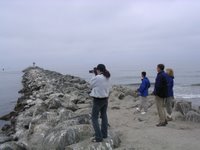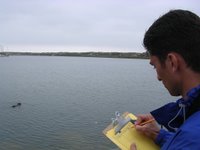
A Great First Day in the Field for Team 5 Sea Otters: Report by Brian and Audioblog by Lynn
Though the weather was cloudy and quite cool, not atypical for Moss Landing and the mouth of Elkhorn Slough in Monterey Bay – even in September, the marine mammal activity was fabulous, perhaps also not atypical. As the Sea Otter monitoring group entered the coastal state park observation area, several dozen harbor seals were lying and resting on the sandy beach along the slough. A multitude of shore birds were active, but for me, most amazing were the dozens of brown pelicans flying all around. At the observation area just inside the breakwater/channel of the slough, about 30 of the roughly 80 southern sea otters that live in the slough were “hanging out”. Shortly after learning the sea otter activity
 monitoring data taking requirements and procedures, the bottlenose dolphin monitoring team on the Bay reported significant dolphin activity just outside the Moss Landing breakwater, so we scurried to the Bay side of the dunes and the jetty. There we saw an active group of dolphins that remained in the general area until we left in the early afternoon. This in fact was atypical, as the dolphins had not been sighted in this area by the Earthwatch teams all summer. The sights were amazing, and included sighting a mother and her calf gallivanting inside the channel. Add to that the numerous harbor seals that curiously checked us out all day, and the occasional sea lion, it was a marine mammal lover’s paradise!
monitoring data taking requirements and procedures, the bottlenose dolphin monitoring team on the Bay reported significant dolphin activity just outside the Moss Landing breakwater, so we scurried to the Bay side of the dunes and the jetty. There we saw an active group of dolphins that remained in the general area until we left in the early afternoon. This in fact was atypical, as the dolphins had not been sighted in this area by the Earthwatch teams all summer. The sights were amazing, and included sighting a mother and her calf gallivanting inside the channel. Add to that the numerous harbor seals that curiously checked us out all day, and the occasional sea lion, it was a marine mammal lover’s paradise!But the neatest sea otter experience occurred on our way home. Just prior to leaving the park area and getting on California Highway 1, we saw a single sea otter in the slough right next to the road. The road was actually a land bridge between two bodies of water in the slough with six buried underwater culverts that facilitated the tidal flow of water under the bridge. As it turned out, this medium grizzled, middle-aged otter was actively foraging clams and mussels. Adult sea otters, weighing
 about 45 – 60 pounds, eat about 15 pounds of food daily to maintain their weight and body temperature. This area of the slough, and in particular the 2 foot diameter culverts, was apparently a rich food source. With the otter so close to the shore and road (sometimes within 30 feet), the team was able to positively identify it as a female, a very rare observation – males are somewhat easy to identify but females can seldom be confirmed unless accompanied by a pup.
about 45 – 60 pounds, eat about 15 pounds of food daily to maintain their weight and body temperature. This area of the slough, and in particular the 2 foot diameter culverts, was apparently a rich food source. With the otter so close to the shore and road (sometimes within 30 feet), the team was able to positively identify it as a female, a very rare observation – males are somewhat easy to identify but females can seldom be confirmed unless accompanied by a pup.We postponed our return to the house for nearly an hour, recording the event as the otter continuously dove and foraged in front of our very eyes. On two occasions she retrieved a cluster of mussels numbering 10-12, and she proceeded to crack
 each shell and devour its contents. When the otter found a particularly large clam, we observed that she would also grab a rock, which it placed on its belly and then used her paws to slam the clam on the rock to break it open. Her final dive seemed to be taking longer than previous dives – she had been surfacing in about 30 seconds because of the good food supply, though otters can stay submerged for up to 5 minutes if necessary – and then we noticed that she had surfaced on the other side of the road! The otter swam through the culvert to the other side, where this summer’s teams had never seen an otter. In fact, that area of the slough had not even been designated a number, so today we assigned it as Area Zero.
each shell and devour its contents. When the otter found a particularly large clam, we observed that she would also grab a rock, which it placed on its belly and then used her paws to slam the clam on the rock to break it open. Her final dive seemed to be taking longer than previous dives – she had been surfacing in about 30 seconds because of the good food supply, though otters can stay submerged for up to 5 minutes if necessary – and then we noticed that she had surfaced on the other side of the road! The otter swam through the culvert to the other side, where this summer’s teams had never seen an otter. In fact, that area of the slough had not even been designated a number, so today we assigned it as Area Zero.It was exciting to observe the otter actively foraging at such close range, and to see the otter do something not previously sighted. It was a great way to end our first day in the field. We are looking forward to more great experiences as we continue our research.

No comments:
Post a Comment